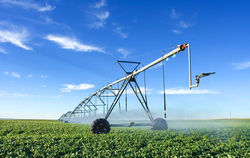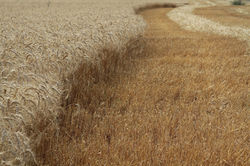Biomimicry
for shaping future
Agriculture
What is biomimicry?
Biomimicry, from bios meaning life and mimesis meaning to imitate, is a new science that looks at nature’s time-tested best ideas and reproduce these designs for healthier and more sustainable technologies for people (Benyus, 1997). The core idea is that nature has actually solved many of the problems we are nowadays facing—as us, organisms and ecosystems need to stay warm, filter water, obtain energy, and so on— and nature has developed solutions that are well-adapted to life on earth through test and error. In this way, nature is the expert on efficiency, adaptiveness and circular systems that can sustain changes and act resilient on changing conditions. Therefore it is an interesting source of information: to get inspired by what already works.
The concept of biomimicry can be applied to numerous fields (energy, architecture, transportation, medicine, communication or agriculture) to create sustainable designs, materials, and technologies in order to harmonize our activities with the planet (Biomimicry institute). Biomimicry can be applied in the process of energy supply by studying a leaf to invent a better solar cell, in flying performance by observing birds to make more aerodynamic wings, in structure organisation by looking at termites to create sustainable air conditioned buildings, and so on.
Our planet Earth has harboured life for 3.8 billion years. Organisms have appeared, evolved, or disappeared when not adapted; they have learned to meet their needs within the limits of the planet and have created intricately interconnected living system in the process (Benyus, 1997). However, in what is just a short blink in earth's history, humankind has expanded in number and territory, meanwhile developing more and more destructive habits in order to shelter and feed that growing population (Benyus, 1997; Vanderbilt, 2012). By forgetting that we are part of, and not separate from, the ecosystems of our planet, our lifestyle has become ecologically unsustainable in many ways.
In the last decades, we have come to realize that our very own existence has pushed nature to the limit of its tolerance and a new thought has emerged: "How can we live on this home planet without destroying it?" (Benyus, 1997).
Innovative approaches have been developed to reconcile human development and nature conservation, but they still too often try to control and manipulate nature instead of cooperate and learn from it (Wahl, 2006). We have a lot to learn from the organisms and ecosystems that surround us, and that have had to solve the same problems as we do, with a far greater economy of means (Benyus, 1997; Pawlyn, 2011). Biomimicry therefore offers the opportunity to reconnect with nature and start living within planetary limits.
Why do we need biomimicry?
Biomimicry in agriculture
Agriculture plays major roles in two striking issues: the environmental footprint and food security. Modern industrialized agriculture is greatly responsible for a range of already irreversible biodiversity loss through the conversion of natural habitats into productive fields, of nitrogen and phosphorus pollution and, of the release of huge amounts of greenhouse gases into the atmosphere (directly through mechanization and livestock production and indirectly by the synthesis of artificial fertilizers) (Rockstrom et al, 2009; Tilman et al, 2002). Agroecological innovations have been long locked out by a technological regime shaping agriculture (e.g. genetic engineering) (Vanloqueren, 2009).
But, as this kind of agriculture helped to the development of humankind thanks to leaps such as the Green Revolution or improved biotechnology, the 21st century will be challenged by food security problems. Agriculture has to provide food, fibre and energy for a rapidly growing population and the actual production won’t be sufficient in the future (FAO, 2011). The Food and Agriculture Organization predicted that, to satisfy the needs of 9.2 billion people by 2050, overall food production would have to increase by about 70 percent. To achieve this goal while respecting the planet, agriculture must adopt more efficient and sustainable production methods.
The application of biomimicry to agriculture is a feasible solution providing this efficient and sustainable approach, and some research is already being conducted. This relates to efficient water use, decreasing the need of pesticide use and subsequent groundwater pollution and nutrient cycling.
A good example is provided by Wes Jackson (Jackson 1996), from the Land Institute, who used prairies for a model of agriculture centred on edible, perennial polycultures. Indeed, these ecosystems are highly efficient in conserving the soil, resisting pests and weeds, and stimulating their own fertility (Benyus, 2011; Jackson, 1996; the Land Institute). In our annual monocultures, the soil has to be tilled and ploughed every year, which leads to erosion. Then we add tons of chemical fertilizers to make up for the poorer soils, and pesticides to protect the crop. By applying the processes of a prairie to an agricultural field, we can create an 'edible prairie', without the need of ploughing and with nitrogen fixing plants taking care of the fertile soils. The mix of species would provide natural pest control.
Another example is the closed-loop coffee plantation. This is inspired by (tropical) ecosystems where nutrients are carefully used and circulated. Where before 99% of the biomass of the coffee plant was produced as waste, the waste is now used as a substrate to grow shiitake mushrooms on (The Biomimicry Institute).
 Echinacea Coneflowers |
|---|
 Succulent Leaves 2 |
 Glistening Spider Webs |
 Green Chameleon |
 Clownfish |
 Berry Branches |
 Cheetah |
 Penguin |
 www.renewableenergymagazine.com |
 Two Flamingos |
 bigbackground.com |
 http://amagico.com |
 Photo by DAVID ILIFF. License: CC-BY |
 inhabitat.com |
 asknature.org |
 me.gatech.edu |
 www.ingurumena.ejgv.euskadi.eus |
 2010 Biomimicry Education Summit |
 http://disinfo.com |
 http://www.being-here.net |
 Almond Tree Flowers |
 Autumn Leaves |
 Cactus |
 Tranquil forest |
 Cherry Blossom |
 Echinacea Coneflowers |
 Fresh Herbs Close Up |
 Lily Pond |
 Open Field |
 Tropical Berries close Up |
 Stalks of Wheat |
 Lush Plants |
 Wheat Field |
 Cluster of Green Leaves |
 Vineyard |
 Man with Hay |
 Sprouting |
 Wind Turbines in the Mountains |
 Picking Cauliflower |
 Agriculture |
 Bee |
 Wheat Field |
References
Benyus J. M. (1997). Biomimicry: Innovations Inspired by Nature. New York: Perennial.
Biomimicry Institute. What is Biomimicry? http://biomimicry.org/. Retrieved March 2015.
FAO (2011).. FAO in the 21st century, Ensuring food security in a changing world. Office of Knowledge Exchange, Research and Extension, FAO, Rome, Italy.
Jackson W. (1996). Becoming Native to This Place. Washington, D.C.: Counterpoint.
Pawlyn M. (2011). Biomimicry in Architecture. RIBA Publishing, London.
The Land Institute. Solutions. http://www.landinstitute.org. Retrieved March 2015.
Vanderbilt T. (2012). How Biomimicry is Inspiring Human Innovation. Smithsonian Magazine.
Vanloqueren G., Baret P.V. (2009). How agricultural research systems shape a technological regime that develops genetic engineering but locks out agroecological innovations, Research Policy, 38(6)
Tilman D., Cassman K. G., Matson P. A., Naylor R., & Polasky S. (2002). Agricultural sustainability and intensive production practices. Nature,418(6898): 671-677.


